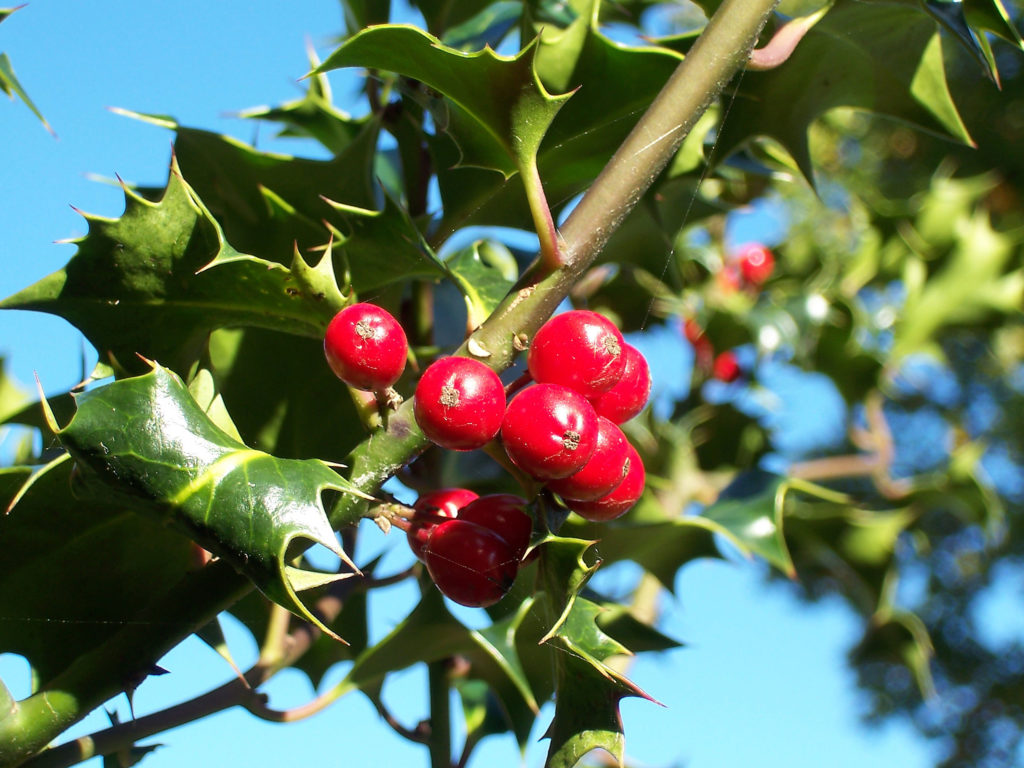Plant Information

Ilex or holly is a genus of about 480 species of flowering plants in the family Aquifoliaceae, and the only living genus in that family. The species are evergreen or deciduous trees, shrubs, and climbers from the tropics to temperate zones worldwide. The common ancestor of most of the extant species probably appeared during the Eocene, about 50 million years ago, suggesting that older representatives of the genus belong to now extinct branches. The first fossil evidence of holly indicates that in first originated in subtropical Asia before expanding its range to every continent except Antarctica. The genus is distributed throughout the world’s different climates, with the greatest diversity found in the more mountainous regions of Asia and South America. The continents of Europe and North America, however, boast some of the more well-known histories of holly leaves. The type species is Ilex aquifolium (English holly), used in Christmas decorations and cards, and range from Europe to western Asia. Other common types include Ilex cornuta (Chinese holly) in Eastern China, Ilex paraguensis (Yerba Mate) in Argentina, Uruguay, Paraguay, central and southeastern Brazil; and Ilex opaca (American holly) in Eastern and south-central regions of the US.
Hollies are very popular in home landscapes for their glossy green leaves, brilliant crimson berries, dense growth habit, and branches that are beautiful in floral arrangements. Depending on the species, they can be grown as specimen plants or accent plants; as attractive privacy-screen hedges or impenetrable tall hedges; as low hedges or borders for garden beds; or as foundation plantings. They are versatile plants that range in height from 1 foot to 70 feet and typically grow in USDA Plant Hardiness Zones 5 to 9. Also there are hollies that thrive in Zones 3 to 11, as this is a rare plant genus that can be grown in all 50 states. The two species most often used for holiday decorations are the American holly (I. opaca) and the English holly (I. aquifolium). Other popular hollies include Inkberry holly (I. glabra), Yaupon holly (I. vomitoria), Carolina holly, (I. ambigua), Myrtle-Leaved holly, (I. myrtifolia), Winterberry holly (I. verticillata), Chinese holly, (I. cornuta) and Japanese holly (I. crenata). Leaves of some holly species are used by some cultures to make daily tea. These species are Yerba mate (I. paraguariensis), Kuding (I. kaushue), Yaupon (I. vomitoria), I. guayusa and others.
Hollies do very well in the home garden, as their care is nominal. Most hollies adapt to many soil types, preferring a moist but well-drained acidic soil of average fertility. Most varieties will grow in full sun or part shade. A minimum of 4 hours of direct sunlight is recommended for best berry production and foliage density. Most holly varieties have male and female plants, with only the female producing berries. This means that growing a holly for its bright berries, requires that a male be planted nearby a female variety. However, there are holly varieties, like ‘Nellie Stevens’, ‘Burford’ and ‘Foster’ follies, that do not need a male plant in order to produce berries. Hollies are mainly pollinated by bees that use them as a great source of pollen and nectar. Fertilize hollies once a year with a balanced fertilizer. They do not need to be watered under normal conditions but irrigate with at least 2 inches per week if drought conditions occur.
Economics
According to the USDA NASS Census of Horticulture, hollies sold for a wholesale value of over $118M in 2014 and $138.5M in 2019.
Main Disease Problems
Hollies have several main disease problems including black spot, Phytophthora leaf and twig blight, Phytophthora and Pythium root rots, Thielaviopsis root rot, sooty mold, leaf spots, Rhizoctonia web blight, Botryosphaeria or bot canker, Sphaeropsis knot, and nematodes.
Main Pest Problems
Hollies have a variety of pests including holly leaf miners, bud moths, spider mites, scale insects, black vine weevil, two-lined spittlebug, and holly aphid.
IR-4 Research
IR-4 has sponsored 368 crop safety trials with 94 products, and we have screened 21 new actives with hollies for effective management of several insect pests (Oriental beetle, Southern red mite, and 6 different species of scale insects) and liverwort. In addition, two studies on plant impact with 7 active ingredients, and for liverwort management with oxyfluorfen, were conducted.
Sources Cited
https://en.wikipedia.org/wiki/Holly
;https://www.plantsnap.com/plantblog/holly-leaf-history/
https://www.gardenersworld.com/plants/10-hollies-to-grow/
;https://todayshomeowner.com/how-to-grow-holly/
https://www.gardeningknowhow.com/ornamental/shrubs/holly/common-types-of-holly.htm
https://www.gardeningknowhow.com/ornamental/shrubs/holly/growing-holly-bushes.htm
https://www.wilsonbrosgardens.com/how-to-plant-a-holly-tree.html
https://www.oregonlive.com/hg/2011/11/holly_in_your_landscape_five_g.html
https://extension.psu.edu/holly-diseases
https://ssl.acesag.auburn.edu/pubs/docs/A/ANR-1087/ANR-1087-archive.pdf
https://edis.ifas.ufl.edu/ep566
USDA-NASS Census of Horticulture, 2018 and 2014
Authors
Ely Vea, IR-4 Environmental Horticulture Program Assistant Manager and Jacqueline Cavaliere, IR-4 Environmental Horticulture Program Coordinator.



